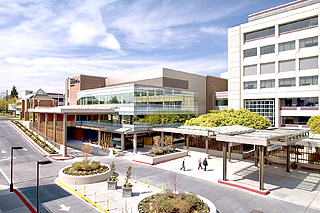|
Subscribe / Renew |
|
|
Contact Us |
|
| ► Subscribe to our Free Weekly Newsletter | |
| home | Welcome, sign in or click here to subscribe. | login |
Architecture & Engineering
| |
 |
June 24, 2010
MultiCare opens $117M Tacoma campus expansion
GBJ Architecture and Skanska USA

Ritter
|

Finney
|
MultiCare Health System opened the Milgard Pavilion to its first emergency patients this spring at MultiCare’s main campus in Tacoma.
The opening marked completion of the first phase of the MultiCare Health System main campus renewal plan, which included expanding the emergency departments at Tacoma General and Mary Bridge Children’s hospitals, developing an express care center and a new home for the MultiCare Regional Cancer Center.
Designed by Portland-based GBJ Architecture and built by Skanska USA, the new $117 million, 194,000-square-foot addition took more than 36 months and 1,600 workers to complete.
With 77 patient exam and treatment rooms on two floors, the emergency department expansion is designed to maximize staffing and census flexibility while addressing the unique needs of adult and pediatric patients. The Tacoma General and Mary Bridge patient care areas are arranged in parallel, sharing common facilities and nursing stations in a central spine on the emergency and express care floors.
The MultiCare Regional Cancer Center, located on the first and fourth floors of the Milgard Pavilion, expands the existing cancer center threefold, bringing all aspects of cancer care into a comprehensive facility. The design includes 27 oncology exam rooms, counseling and resource rooms, dedicated spaces for complementary therapies such as massage and yoga, and 40 semiprivate and private infusion chairs clustered in spaces with ample daylight and expansive views.
On a site tightly constrained by topography, infrastructure and existing campus buildings, the project connects disparate parts into a revitalized whole. It clusters new outpatient and emergency department entrances around a plaza.
New public and staff connections are designed to facilitate wayfinding with architectural elements that combine to create a recognizable identity for the hospital. The brick and precast exterior and sculptural form of the chapel located at the south end of the building honor the United Methodist Church, which formerly occupied the site.
A transfer of power
One of the first hurdles the design and construction team had to overcome in the construction of the Milgard Pavilion was replacement of the critical power supply for the hospital’s existing emergency department and critical care tower. The existing transformer vaults were located within the footprint of the new building, and mass excavation could not be completed until the new power supply could be brought online.
The solution involved the early completion of a new transformer room, creating a completed and fully functioning space at the lowest level of the expansion building, and constructing the remainder of the project around it. A great deal of care and planning was required for a successful transfer of power due to its critical nature and the sensitive departments it feeds.
Engineered to resist a 2,500-year seismic event, the 25-foot depth of the large concrete footings of the new building required mass excavation to allow work on the new vault to begin. Shoring in place allowed construction to proceed on the concrete vault that houses the new transformer room and forms a critical portion of the new building’s foundation and basement structure.
The transformer room itself needed to be robust, watertight and fully functional with heating, lighting and fire protection services during the two years needed to construct the remainder of the five-story building around it.
Coordinating the work
MultiCare’s main campus remained fully operational during construction of the Milgard Pavilion. This required detailed planning to ensure comprehensive infection control and no disruptions to hospital operations.
Specific challenges included the extensive integration of old and new hospital systems at points of connection. There were a total of 21 entry points between existing hospital buildings and the new expansion. All sky bridges, hallways and doorways had to seamlessly connect.
Skanska led the coordination between the contracting and design team members providing as-built information. They drove detail and shop drawing integration at each point of connection to ensure that all structural, mechanical and electrical systems connected glitch free and to minimize impacts to the hospital.
A tight fit
| |
|
GBJ Architecture, Portland General contractor: Skanska, Seattle Interiors: MultiCare Construction Services, Tacoma; Czopek & Erdenberger, Portland Structural engineer: PCS Structural Solutions, Tacoma Mechanical engineer: CDi Engineers, Lynnwood Electrical engineer: Sparling, Portland Civil engineer: KPFF Consulting Engineers, Tacoma Landscape architect: Site Workshop, Seattle |
Constrained by both time and space, the construction of the new linear accelerator vault — a radiation shielding envelope that filters out all forms of radiation generated during therapeutic treatments — was a Rubik’s Cube-type of challenge for the design and contracting teams.
A linear accelerator uses advanced radiation technology to pinpoint cancer cells. These rooms are traditionally built with 6-foot-deep concrete walls. However, this vault was to be located under the ambulance driveway, where the structural slab elevation is determined by fire truck clearances, leaving a limited floor-to-floor height.
Within these constraints the team opted for a design-build system of steel, lead and proprietary shielding block that significantly reduced the amount of space that a traditional vault demands. There was tight coordination between all trades to ensure a fit within the prescribed envelope and to prevent radiation penetration.
In order to take advantage of the latest available technology, the selection of the radiation therapy equipment was finalized when the building structure and floor buildout was nearly complete.
The completion of the shielding shop drawings, construction of the shielding envelope and finishes, and installation of the equipment were compressed into an 18-week time frame. This required intense collaboration between the owner, users, design team, equipment vendors and subcontractors, as well as creative solutions to staging and impact mitigation at every step of construction.
None of these feats of engineering, construction and technology is transparent to the patients in the finished spaces.
“Our new emergency department provides a healthy, healing environment that will allow our staff to provide high-quality care to our community,” said Crystal Billings, nurse manager of the Tacoma General Emergency Department.
“The calming, spacious, private rooms and high-tech equipment will allow us to meet the needs of our customers in a way that we have previously been unable to. Our staff will be able to apply their skill and training in a whole new way to really create a world-class experience for our patients and their families.”
With the Milgard Pavilion up and running, construction is now under way to remodel 22,700 square feet in the adjacent Olympics and Philip pavilions. The remodeled projects are expected to reopen in winter of 2011.
Kimberly Ritter is an associate at GBJ Architecture, and Ben Finney is a senior project manager at Skanska USA.
Other Stories:
- Mental health clinic breaking ground in Burien
- Hospitals: get ready for climate change laws
- Federal program keeps money flowing for hospital projects
- Surgical advances create ‘hybrid’ operating rooms
- Robots bring changes to operating room design
- In wake of reform, hospitals try doing more with less
- Hospital noise rules get an update



